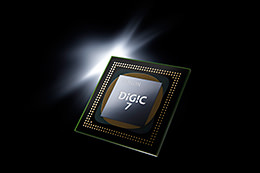On 18 February 2016, Canon announced the PowerShot G7 X Mark II, the successor to the PowerShot G7 X, its premium compact with a 1.0-inch type sensor said to be the best-selling camera in Japan in 2015. Why the ”Mark II” label for the new version of the best-seller? In Part 1 of this interview, we ask its developers about this, and also find out more about the development concept and the inclusion of the DIGIC 7 image processor.

(from left)

Chief of design
Hideaki Yamaki
Manager ICP Development Center 3, Image Communication Products Operations
Image quality
Kota Terayama
ICP R&D Center 2, Image Communication Products Operations

IS
Shimpei Miyahara
ICP R&D Center 2, Image Communication Products Operations
Product planning
Yoshikazu Sakagami
ICP Group 3, Image Communication Products Operations
PowerShot G7 X –The ultimate balance of excellent image quality and a compact form
- What is the position of the PowerShot G7 X Mark II in the G series?
Sakagami: The PowerShot G series has always pursued the best in image quality and controls. To ensure the joy of shooting with and the joy of owning a G series model, all of Canon’s best features are incorporated into the design, from the large 1.0-type sensor, to the lens, imaging processor, and exterior design. The PowerShot G7 X line is built on the concept of excellent image quality in a pocket-sized camera, providing the perfect balance between the size of a compact digital camera, excellent image quality, and high performance. This line is at the core of the G series where users can experience the true pleasure of a premium compact with excellent image quality in a small package.
Yamaki:The PowerShot G7 X Mark II is the next step in the evolution of the series. An integrated lens construction unique to compact cameras is utilized along with an optimized sensor and lens to create the next level of perfect balance between image quality that rivals the EOS and a size that feels like a compact camera.

The concept behind each PowerShot G-series camera is as follows:
- Powershot G1 X Mark II: FLAGSHIP
- Powershot G3 X: HIGH ZOOM
- Powershot G5 X: EVF
- Powershot G7 X Mark II: Compact & High Performance
- Powershot G9 X: SLIM
Advances in all directions focused on the DIGIC 7
- What advancements have been made since the PowerShot G7 X?
Sakagami: A number of advancements have been made based on user feedback, but the biggest was the switch to the new DIGIC 7. Not only does this improve image quality, but also detection and tracking performance and image stabilization. New shooting features such as panning have also been added.
Yamaki: Yes, that’s true and the power of the lens and sensor are also significant. The PowerShot G7 X and G5 X were equipped with a 4.2x optical zoom f/1.8 (W) – f/2.8 (T) and 1.0-type sensor, and each of these models were masterpieces. Additionally, the accumulation of fine-tuning knowhow from our experience with this makes it possible to maximize DIGIC 7’s high performance to strike the perfect balance between a compact form and excellent image quality, making this truly the best possible design.
Sakagami: I also think the inclusion of Picture Style and in-camera RAW image processing on the PowerShot G7 X Mark II, which are familiar features from the EOS, are major points. There are also significant advances in controls and convenience with a new grip, the ability to switch between step and continuous control, and USB charging.


DIGIC 7 possesses powerful data processing abilities. When combined with a high performing Canon lens and a 1.0-inch type sensor, there is a significant improvement in shooting performance.
All-around camera that expands daily photo opportunities
- What advancements have been made since the PowerShot G7 X?
Sakagami: The compact body size means that it can be taken anywhere at any time, and this one model will cover a variety of scenes. This all-around ability is the most significant appeal of the camera. The more chances you have to take the camera with you, the more possibilities for photo opportunities you’ll encounter. Because of this, the camera is capable of shooting in a wide variety of situations, from using the bright lens and 1.0-type sensor to achieve beautiful defocusing effects in snapshots, to high-sensitivity shooting in dark scenes, stopping down the aperture for landscape shots, and providing image quality that can satisfy SLR users.
Also, simply having good image quality is not enough. Without long battery life, good controls, and a quick response, you’ll miss a great photo opportunity. These features are all advanced on the PowerShot G7 X Mark II, achieving even higher standards for a compact digital camera. I believe it is a reliable backup for EOS users and a good step-up model for smartphone or standard compact camera users, as well as a great all-around camera with excellent image quality and mobility.

The PowerShot G7 X Mark II packs high shooting power into a portable, compact body size.
DIGIC 7 –Bringing images to new heights
- What advancements has DIGIC 7 brought to the camera?
Yamaki: The DIGIC 7 is based on the DIGIC 6 with overall improvements. Shooting functions include improvements to subject detection and tracking, as well as significant improvements to image stabilization performance. Noise reduction has advanced and resolution is also improved* during high sensitivity shooting for better image quality. Additionally, resolution is improved for small aperture shooting and compensation for diffractive blurring has also advanced.
* PowerShot G7 X Mark II, same lens and sensor for DIGIC 6. Comparison with models including this feature (ISO 3200 and lower)
- Can you give some details on improvements to subject detection and tracking?
Terayama: The DIGIC 7 features advanced image analyzation technology using subject information. This allows for significant detection and tracking performance improvements. Detection performance is improved for subjects that are difficult to detect, such as those with low color saturation and subjects that are in the same color range as the background. This makes high-precision tracking possible even in scenes where subjects change position and move around. Mistaken tracking of human subjects is reduced in situations such as when a person crosses in front of another, or momentarily moves out of frame.
Yamaki: Another major point is the significantly reduced LCD display time lag. Compared with the PowerShot G7 X, this feature has been improved by approximately 50% so that even quick-moving subjects can be displayed in real time, ensuring you never miss a photo opportunity.

1/250 sec., f/8, ISO 125
DIGIC 7 helps to prevent the occurrence of diffractive blur even during shooting at wide apertures. You get sharper images as a result.
4-stop* compensation, perfect for strong body shake
- What improvements have been made to image stabilization (IS)?
Miyahara: On the previous version of IS, the optical IS unit was controlled based on angular shake information detected by the gyro sensor. This model adds image blur information from the shooting sensor for controlling the IS unit. Because it is possible to analyze image blur in real time based on image information from DIGIC 7, this can be utilized for image stabilization. In addition, a new algorithm was developed that merges angular blur information from the gyro sensor and image information, and high-precision IS unit control makes 4-stop image stabilization possible. This is 1 full stop* higher than the PowerShot G7 X’s 3 stops.
* Still images only. CIPA compliant.
- Besides the increase in IS stops, what other IS merits stem from the increase in available image information?
Miyahara: The use of angular blur information from the gyro sensor helps the IS correct fine high-frequency shaking such as camera shake. However, such information is not as useful for low-frequency shaking such as slow body shake. When holding the camera, your body slowly shakes without your realization even when you try to stop moving. This type of shake is difficult to counter. On the other hand, IS based on image information is useful for such low-frequency shaking. Utilizing both of these properties together makes powerful IS possible in every direction, regardless of whether it is against fine, high-frequency camera shake or slow, low-frequency shaking.

A: IS Unit/ B: Gyro sensor/ C: Imaging sensor/ D: DIGIC 7
1) Red arrow: Image information is processed.
2) Black arrow: Information from the shake-detecting gyro sensor will still be used and processed.
DIGIC 7 processes two types of information, and this enables significant improvement in IS performance, enabling the stabilization not only of camera shake up to 4 shutter speed stops, but also the effects of slow, significant shaking caused by body movement.
With approximately 14x more data processed, resolution is maintained* even at high ISO speed
- How is performance at high ISO speed?
Terayama: Processing has been reworked for improved noise reduction performance. Problems with the amount of information handled during noise reduction processing on the DIGIC 6 made it impossible to distinguish between noise and texture, resulting in texture loss and insufficient noise reduction.
However, because the DIGIC 7 can handle approximately 14 times more data than DIGIC 6, higher precision processing is possible. Noise that occurs around the edges of images is reduced, maintaining high resolution even at high ISO speed settings *.
On the PowerShot G7 X Mark II, an ISO speed of 1600 allows you to do much more than before. Its noise reduction on the edges of images is almost as good as that at ISO 800 on the PowerShot G7 X, and that’s one of the factors behind the improved image resolution.
* PowerShot G7 X Mark II, same lens and sensor for DIGIC 6. Comparison with models including this feature (ISO 3200 and lower)
- Are there any other advancements in image quality?
Terayama: Correction of diffraction blurring even at small apertures has been added. This is possible because DIGIC 7’s high-speed processing performance is used along with optical information. Be sure to experience this for yourself in dynamic landscape shots and performance shooting.
Yamaki: Also, the EOS Auto Lighting Optimizer (ALO) is included on this model for the first time on a compact digital camera. As the first model to be equipped with DIGIC 7, this camera features even more advanced ALO performance than on the EOS M3. This makes it possible to compensate the brightness while maintaining contrast, making it a perfect feature you can actively use to photograph people in backlit scenes.

1/80sec., f/2.8, ISO 1600
When you shoot at high ISO speeds such as ISO 1600, you get noise suppression almost as good as that at ISO 800 on the PowerShot G7 X.

Auto Lighting Optimizer ON (Standard)

Auto Lighting Optimizer OFF
Efficient power performance for confident shooting
- Are improvements to tracking, IS, shooting functions, and image quality due to DIGIC 7?
Yamaki: In addition to these, a major feature is its power saving performance. When compared with the PowerShotG7 X, many parts have been reworked, and the DIGIC 7 has been added, which contributes significantly to energy saving. This enables approximately 265* shots on the PowerShot G7 X Mark II over the 210* shots on the PowerShot G7 X.
*When using LCD monitor display (according to CIPA standards).
Continued battery operation is a major issue when taking your camera out to shoot. I believe this improvement will let users fully enjoy shooting without worrying about battery life.


PowerShot G7 X Mark II

































